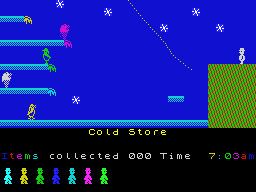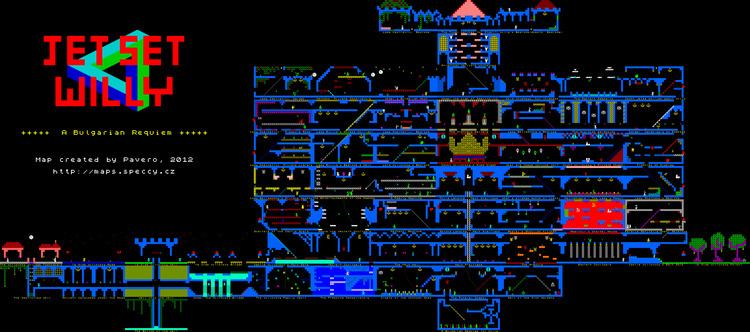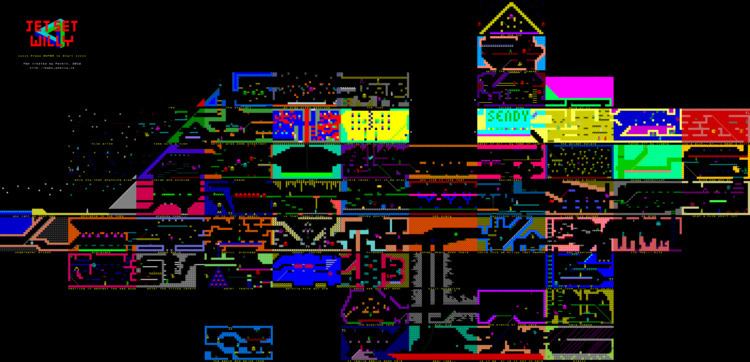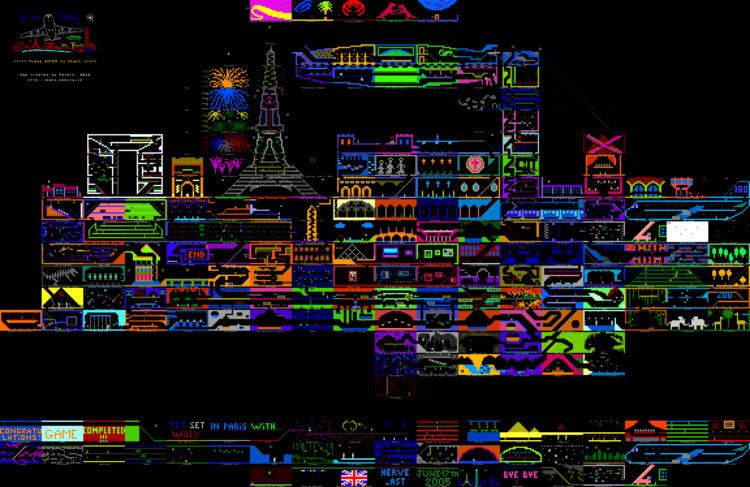7.8 /10 1 Votes
Genre(s) Platformer Initial release date 1984 | 3.9/5 Classic Retro Games Mode(s) Single player | |||||||||||||||||||||||||||||||||
 | ||||||||||||||||||||||||||||||||||
Release date(s) Spectrum1984Atari 8-bit1987 Similar Elite Systems games, platform games | ||||||||||||||||||||||||||||||||||
Jet Set Willy is a platform video game originally written by Matthew Smith for the ZX Spectrum home computer. It was published in 1984 by Software Projects and ported to most home computers of the time.
Contents
- Jet set willy complete walkthrough
- Plot
- Gameplay
- Reception
- Bugs
- The Quirkafleeg
- Protecting against piracy
- Third party modifications
- Ports
- References

The game is a sequel to Manic Miner published in 1983, and is the second game in the Miner Willy series. It was a significant development in the platform game genre on the home computer.

Jet set willy complete walkthrough
Plot

A tired Miner Willy has to tidy up all the items left around his house after a huge party. With this done his housekeeper Maria will allow him access to his bedroom. Willy's mansion was bought with the wealth obtained from his adventures in Manic Miner but much of it remains unexplored and it appears to be full of strange creatures, possibly a result of the previous (missing) owner's experiments. Willy must explore the enormous mansion and its grounds (including a beach and a yacht) to fully tidy up the house so he can get some much-needed sleep.
Gameplay

Jet Set Willy is a flip-screen platform game in which the player moves the protagonist, Willy, from room to room in his mansion collecting objects. The game is an early example of a nonlinear title since, unlike the screen-by-screen style of its prequel, the player can explore the mansion at will. Willy is controlled using only left, right and jump. He can climb stairs by walking into them (jumping through them to avoid them) and climb swinging ropes by pushing left or right depending on what direction the rope is swinging. The play area itself consists of 61 screens making up the mansion and its grounds and contains hazards (static killer objects), guardians (killer monsters which move along predetermined paths), various Platform(s) and collectable objects. The collectable items glow to distinguish them from other objects in the room.

Willy loses a life if he touches an enemy or falls too far, and he is returned to the point at which he entered the room. This may lead to a game-ending situation in which Willy repeatedly falls from a height, losing all lives in succession.

Music on the Spectrum version was Beethoven's Moonlight Sonata for the menu, and If I Were a Rich Man or Grieg's 'In the Hall of the Mountain King' during the game itself.
Music on the C64 version was Beethoven's Moonlight Sonata during loading, and J.S. Bach - Inventions # 1 during gameplay.
Reception
Reviewing Jet Set Willy for Your Spectrum magazine in June 1984, Sue Denham wrote that the game was "every bit as good and refreshing as the original".
The game was number one in the UK Spectrum sales chart for several months, until it was replaced by Sabre Wulf. The ZX Spectrum version was voted the 6th best game of all time in a special issue of Your Sinclair magazine in 2004.
The game was included on the 1985 compilation They Sold a Million, along with Beach-Head, Daley Thompson's Decathlon and Sabre Wulf.
Bugs
As originally released, the game could not be completed due to several bugs. Although actually four completely unrelated issues, they became known collectively as "The Attic Bug". After the player entered the room The Attic, various rooms would undergo corruption on all subsequent game plays, including all monsters disappearing from The Chapel, and other screens triggering instant death. This was caused by an error in the path of an arrow in The Attic, resulting in the sprite travelling past the end of the Spectrum's video memory and overwriting crucial game data instead. This bears similarities to a buffer overflow, and as such is an early example of such an error — and the problems it can cause.
Initially Software Projects attempted to pass this bug off as an intentional feature to make the game more difficult, claiming that the rooms in question were filled with poison gas. However, they later rescinded this claim and issued a set of POKEs to correct the flaws.
Other bugs included an item under The Conservatory Roof placed too close to both the screen entrance and a killer object making it impossible to collect. The Software Projects fix removed the killer object. There was also an invisible and impossible to reach item in First Landing. The Software Projects fix relocated the item to The Hall — although some fixes relocated the object to The Bathroom where it became visible as another tap item, by poking value 33, instead of 11.
The Banyan Tree was impassable in an upward direction — the Software Projects fix changed the status of an essential block from solid to passable.
Despite these bugs, Ross Holman and Cameron Else won the competition that Software Projects had set for completion of Jet Set Willy and provided Software Projects with a set of bug fixes. Software Projects then hired Cameron Else to port both Manic Miner and Jet Set Willy to the MSX.
The Quirkafleeg
One of the more bizarrely named rooms in the game is We Must Perform A Quirkafleeg. (The pre-release name for the screen was "The Gaping Pit".) This is a reference to the comic strip Fat Freddy's Cat, a spin-off from the Fabulous Furry Freak Brothers; in the original comic, the quirkafleeg was an obscure ritual in a foreign country, required to be performed upon the sight of dead furry animals.
Protecting against piracy
Like most ZX Spectrum games, Jet Set Willy was stored on a cassette tape. Simply making an audio copy of the cassette allowed people to easily copy Spectrum games. Jet Set Willy was one of the first to come with a form of copy protection: a card with 180 coloured codes on it was bundled with the cassette. Upon loading, one of the codes from the card had to be entered before the game would start. Although the cassette could be duplicated, a copy of the card was also needed and at the time, home colour reproduction was hard to do. Thus copying Jet Set Willy was trickier than most Spectrum games. However, means of circumventing the card were quickly found, and, reflecting the attitude to software piracy at the time, one method was published in a UK computer magazine.
Third-party modifications
In its original Spectrum version, Jet Set Willy has a clear separation between the game engine and the data describing the rooms. The rooms themselves are stored in a straightforward format, with no compression. It is therefore relatively easy to create customised versions of the game.
The review of JSW in issue 4 of Your Spectrum included a section entitled 'JSW — A Hacker's Guide'; remarks in this section imply that the author had successfully deduced at least some of the data structures, since he was able to remove sections of wall in the Master Bedroom. The following year, issue 13 contained a program that added an extra room ("April Showers") to the game, and issue 15 described the data formats in detail.
Several third-party editing tools were published between 1984 and 1986, allowing players to design their own rooms and sprites. Since then, these and other programs have been used by fans to create many modified versions of JSW, ranging from relatively minor changes in a few rooms to completely new games. In recent years, a Windows-based JSW editor has been created.
Ports
The following ports to other computer platforms were made.
Jet Set Willy: The Final Frontier, an expanded version for the Amstrad CPC, was later converted back to the ZX Spectrum and released as Jet Set Willy II. Both the original game and Jet Set Willy II were released for the BBC Micro, Acorn Electron, MSX, Commodore 16 and Commodore 64. The original releases of Jet Set Willy for the BBC Micro and the Commodore 64 also contained bugs which made it impossible to complete the game — though different bugs to the Spectrum version. In the Commodore 64 version, it was impossible to reach all of the items in the Wine Cellar.
A differently expanded version of Jet Set Willy was released for the Dragon 32/64, with extra rooms. This version could also not be completed as it was impossible to traverse The Drive in a right-to-left direction, which was necessary to return to bed after collecting all the items. The game could, however, be completed using a built-in cheat, accessed by holding down the keys M, A and X simultaneously, allowing you to start Willy from any position on any screen, using the arrow keys and spacebar.
The Dragon port was itself converted to run on the Acorn Archimedes computers. The port made use of colour — the Dragon version being in black and white — but apart from this, no advantage was taken of the Archimedes' superior hardware compared to that of the Dragon, however better collision detection meant that "The Drive" could be completed right-to-left, unlike on the Dragon.
There are two versions of the original Jet Set Willy for the MSX. The Software Projects version that was sold in the UK is dated 1984 and was programmed by Cameron Else, co-winner of the Jet Set Willy competition as mentioned above. The other version was published by Hudson Soft in 1985 as a Bee Card in Japan.
A port of Jet Set Willy to the Atari 8-bit family of computers was released by Tynesoft in 1987. It received generally poor reviews which criticised inferior graphics and animation; however, Rob Hubbard's theme music, unique to this version, was considered a highlight. Like the Spectrum version, it was impossible to complete but for different reasons. Some of the legitimate items that were needed caused the player to lose a life (e.g. the bottles in the Off Licence). Krzysztof Dudek ported the original ZX Spectrum code to the 8-bit Atari in 2007, creating a much more authentic version of the game than the Tynesoft version, but kept the Rob Hubbard soundtrack. In 2015 a TI-99/4A port was done by Rasmus Moustgaard.
Software Projects made ports to the Commodore Amiga and Atari ST but cancelled them before they were released, although Manic Miner and Jet Set Willy II were later released on the Commodore Amiga.
